- Home
- Jared Diamond
The World Until Yesterday: What Can We Learn From Traditional Societies? Page 2
The World Until Yesterday: What Can We Learn From Traditional Societies? Read online
Page 2
All of those differences between the 2006 and 1931 crowds can be summed up by saying that, in the last 75 years, the New Guinea Highland population has raced through changes that took thousands of years to unfold in much of the rest of the world. For individual Highlanders, the changes have been even quicker: some of my New Guinea friends have told me of making the last stone axes and participating in the last traditional tribal battles a mere decade before I met them. Today, citizens of industrial states take for granted the features of the 2006 scene that I mentioned: metal, writing, machines, airplanes, police and government, overweight people, meeting strangers without fear, heterogeneous populations, and so on. But all those features of modern human societies are relatively new in human history. For most of the 6,000,000 years since the proto-human and proto-chimpanzee evolutionary lines diverged from each other, all human societies lacked metal and all those other things. Those modern features began to appear only within the last 11,000 years, in just certain areas of the world.
Thus, New Guinea* is in some respects a window onto the human world as it was until a mere yesterday, measured against a time scale of the 6,000,000 years of human evolution. (I emphasize “in some respects”—of course the New Guinea Highlands of 1931 were not an unchanged world of yesterday.) All those changes that came to the Highlands in the last 75 years have also come to other societies throughout the world, but in much of the rest of the world those changes appeared earlier and much more gradually than in New Guinea. “Gradual,” however, is relative: even in those societies where the changes appeared first, their time depth of less than 11,000 years is still minuscule in comparison with 6,000,000 years. Basically, our human societies have undergone profound changes recently and rapidly.
Why study traditional societies?
Why do we find “traditional” societies so fascinating?* Partly, it’s because of their human interest: the fascination of getting to know people who are so similar to us and understandable in some ways, and so unlike us and hard to understand in other ways. When I arrived in New Guinea for the first time, in 1964 at the age of 26, I was struck by the exoticness of New Guineans: they look different from Americans, speak different languages, dress differently, and behave differently. But over the subsequent decades, in the course of my making dozens of visits of one to five months each to many parts of New Guinea and neighboring islands, that predominant sense of exoticness yielded to a sense of common ground as I came to know individual New Guineans: we hold long conversations, laugh at the same jokes, share interests in children and sex and food and sports, and find ourselves angry, frightened, grief-stricken, relieved, and exultant together. Even their languages are variations on familiar worldwide linguistic themes: although the first New Guinea language that I learned (Fore) is unrelated to Indo-European languages and hence has a vocabulary that was completely unfamiliar to me, Fore still conjugates verbs elaborately like German, and it has dual pronouns like Slovenian, postpositions like Finnish, and three demonstrative adverbs (“here,” “there nearby,” and “there faraway”) like Latin.
All those similarities misled me, after my initial sense of New Guinea’s exoticness, into thinking, “People are basically all the same everywhere.” No, I eventually came to realize, in many basic ways we are not all the same: many of my New Guinea friends count differently (by visual mapping rather than by abstract numbers), select their wives or husbands differently, treat their parents and their children differently, view danger differently, and have a different concept of friendship. This confusing mixture of similarities and differences is part of what makes traditional societies fascinating to an outsider.
Another reason for the interest and importance of traditional societies is that they retain features of how all of our ancestors lived for tens of thousands of years, until virtually yesterday. Traditional lifestyles are what shaped us and caused us to be what we are now. The shift from hunting-gathering to farming began only about 11,000 years ago; the first metal tools were produced only about 7,000 years ago; and the first state government and the first writing arose only around 5,400 years ago. “Modern” conditions have prevailed, even just locally, for only a tiny fraction of human history; all human societies have been traditional for far longer than any society has been modern. Today, readers of this book take for granted farm-grown and store-bought food rather than wild food hunted and gathered daily, tools of metal rather than of stone and wood and bone, state government and its associated law courts and police and armies, and reading and writing. But all of those seeming necessities are relatively new, and billions of people around the world today still live in partly traditional ways.
Embedded even within modern industrial societies are realms where many traditional mechanisms still operate. In many rural areas of the First World, such as the Montana valley where my wife and children and I spend our annual summer vacations, many disputes are still resolved by traditional informal mechanisms rather than by going to court. Urban gangs in large cities don’t call the police to settle their disagreements but rely on traditional methods of negotiation, compensation, intimidation, and war. European friends of mine who grew up in small European villages in the 1950s described childhoods like those in a traditional New Guinea village: everybody knew everybody else in the village, everyone knew what everyone else was doing and expressed their opinions about it, people married spouses born only a mile or two distant, people spent their entire lives in or near the village except for young men away during the world war years, and disputes within the village had to be settled in a way that restored relationships or made them tolerable, because you were going to be living near that person for the rest of your life. That is, the world of yesterday wasn’t erased and replaced by a new world of today: much of yesterday is still with us. That’s another reason for wanting to understand yesterday’s world.
As we shall see in this book’s chapters, traditional societies are far more diverse in many of their cultural practices than are modern industrial societies. Within that range of diversity, many cultural norms for modern state societies are far displaced from traditional norms and lie towards the extremes of that traditional range of diversity. For example, compared to any modern industrial society, some traditional societies treat elderly people much more cruelly, while others offer elderly people much more satisfying lives; modern industrial societies are closer to the former extreme than to the latter. Yet psychologists base most of their generalizations about human nature on studies of our own narrow and atypical slice of human diversity. Among the human subjects studied in a sample of papers from the top psychology journals surveyed in the year 2008, 96% were from Westernized industrial countries (North America, Europe, Australia, New Zealand, and Israel), 68% were from the U.S. in particular, and up to 80% were college undergraduates enrolled in psychology courses, i.e., not even typical of their own national societies. That is, as social scientists Joseph Henrich, Steven Heine, and Ara Norenzayan express it, most of our understanding of human psychology is based on subjects who may be described by the acronym WEIRD: from Western, educated, industrialized, rich, and democratic societies. Most subjects also appear to be literally weird by the standards of world cultural variation, because they prove to be outliers in many studies of cultural phenomena that have sampled world variation more broadly. Those sampled phenomena include visual perception, fairness, cooperation, punishment, biological reasoning, spatial orientation, analytic versus holistic reasoning, moral reasoning, motivation to conform, making choices, and concept of self. Hence if we wish to generalize about human nature, we need to broaden greatly our study sample from the usual WEIRD subjects (mainly American psychology undergraduates) to the whole range of traditional societies.
While social scientists can thus surely draw conclusions of academic interest from studies of traditional societies, all the rest of us may also be able to learn things of practical interest. Traditional societies in effect represent thousands of natural experiments in how to construct a h
uman society. They have come up with thousands of solutions to human problems, solutions different from those adopted by our own WEIRD modern societies. We shall see that some of those solutions—for instance, some of the ways in which traditional societies raise their children, treat their elderly, remain healthy, talk, spend their leisure time, and settle disputes—may strike you, as they do me, as superior to normal practices in the First World. Perhaps we could benefit by selectively adopting some of those traditional practices. Some of us already do so, with demonstrated benefits to our health and happiness. In some respects we moderns are misfits; our bodies and our practices now face conditions different from those under which they evolved, and to which they became adapted.
But we should also not go to the opposite extreme of romanticizing the past and longing for simpler times. Many traditional practices are ones that we can consider ourselves blessed to have discarded—such as infanticide, abandoning or killing elderly people, facing periodic risk of starvation, being at heightened risk from environmental dangers and infectious diseases, often seeing one’s children die, and living in constant fear of being attacked. Traditional societies may not only suggest to us some better living practices, but may also help us appreciate some advantages of our own society that we take for granted.
States
Traditional societies are more varied in their organization than are societies with state government.* As a starting point to help us understand unfamiliar features of traditional societies, let’s remind ourselves of the familiar features of the nation-states in which we now live.
Most modern nations have populations of hundreds of thousands or millions of people, ranging up to over a billion people each for India and China, the two most populous modern nations. Even the smallest separate modern nations, the Pacific island countries of Nauru and Tuvalu, contain over 10,000 people each. (The Vatican, with a population of only 1,000 people, is also classified as a nation, but it’s exceptional as a tiny enclave within the city of Rome, from which the Vatican imports all of its necessities.) In the past as well, states had populations ranging from tens of thousands up to millions. Those large populations already suffice to tell us how states have to feed themselves, how they have to be organized, and why they exist at all. All states feed their citizens primarily by means of food production (agriculture and herding) rather than by hunting and gathering. One can obtain far more food by growing crops or livestock on an acre of garden, field, or pasture that we have filled with the plant and animal species most useful to us, than by hunting and gathering whatever wild animal and plant species (most of them inedible) happen to live in an acre of forest. For that reason alone, no hunter-gatherer society has ever been able to feed a sufficiently dense population to support a state government. In any state, only a portion of the population—as low as 2% in modern societies with highly mechanized farms—grows the food. The rest of the population is busy doing other things (such as governing or manufacturing or trading), doesn’t grow its own food, and instead subsists off the food surpluses produced by the farmers.
The state’s large population also guarantees that most people within a state are strangers to each other. It’s impossible even for citizens of tiny Tuvalu to know all 10,000 of their fellow citizens, and China’s 1.4 billion citizens would find the challenge even more impossible. Hence states need police, laws, and codes of morality to ensure that the inevitable constant encounters between strangers don’t routinely explode into fights. That need for police and laws and moral commandments to be nice to strangers doesn’t arise in tiny societies, in which everyone knows everyone else.
Finally, once a society tops 10,000 people, it’s impossible to reach, execute, and administer decisions by having all citizens sit down for a face-to-face discussion in which everyone speaks his or her mind. Large populations can’t function without leaders who make the decisions, executives who carry out the decisions, and bureaucrats who administer the decisions and laws. Alas for all of you readers who are anarchists and dream of living without any state government, those are the reasons why your dream is unrealistic: you’ll have to find some tiny band or tribe willing to accept you, where no one is a stranger, and where kings, presidents, and bureaucrats are unnecessary.
We’ll see in a moment that some traditional societies were populous enough to need general-purpose bureaucrats. However, states are even more populous and need specialized bureaucrats differentiated vertically and horizontally. We state citizens find all those bureaucrats exasperating: alas again, they’re necessary. A state has so many laws and citizens that one type of bureaucrat can’t administer all of the king’s laws: there have to be separate tax collectors, motor vehicle inspectors, policemen, judges, restaurant cleanliness inspectors, and so on. Within a state agency containing just one such type of bureaucrat, we’re also accustomed to the fact that there are many officials of that one type, arranged hierarchically on different levels: a tax agency has the tax agent who actually audits your tax return, serving under a supervisor to whom you might complain if you disagree with the agent’s report, serving in turn under an office manager, serving under a district or state manager, serving under a commissioner of internal revenue for the whole United States. (It’s even more complicated in reality: I omitted several other levels for the sake of brevity.) Franz Kafka’s novel The Castle describes an imaginary such bureaucracy inspired by the actual bureaucracy of the Habsburg Empire of which Kafka was a citizen. Bedtime reading of Kafka’s account of the frustrations faced by his protagonist in dealing with the imaginary castle bureaucracy guarantees me a sleep filled with nightmares, but all of you readers will have had your own nightmares and frustrations from dealing with actual bureaucracies. It’s the price we pay for living under state governments: no utopian has ever figured out how to run a nation without at least some bureaucrats.
A remaining all-too-familiar feature of states is that, even in the most egalitarian Scandinavian democracies, citizens are politically, economically, and socially unequal. Inevitably, any state has to have a few political leaders giving orders and making laws, and lots of commoners obeying those orders and laws. State citizens have different economic roles (as farmers, janitors, lawyers, politicians, shop clerks, etc.), and some of those roles carry higher salaries than do other roles. Some citizens enjoy higher social status than do other citizens. All idealistic efforts to minimize inequality within states—e.g., Karl Marx’s formulation of the communist ideal “From each according to his abilities, to each according to his needs”—have failed.
There could be no states until there was food production (beginning only around 9000 BC), and still no states until food production had been operating for enough millennia to build up the large, dense populations requiring state government. The first state arose in the Fertile Crescent around 3400 BC, and others then arose in China, Mexico, the Andes, Madagascar, and other areas over the following millennia, until today a world map shows the entire planet’s land area except for Antarctica divided into states. Even Antarctica is subject to partly overlapping territorial claims by seven nations.
Types of traditional societies
Thus, before 3400 BC there were no states anywhere, and in recent times there have still been large areas beyond state control, operating under traditional simpler political systems. The differences between those traditional societies and the state societies familiar to us are the subject of this book. How should we classify and talk about the diversity of traditional societies themselves?
While every human society is unique, there are also cross-cultural patterns that permit some generalizations. In particular, there are correlated trends in at least four aspects of societies: population size, subsistence, political centralization, and social stratification. With increasing population size and population density, the acquisition of food and other necessities tends to become intensified. That is, more food is obtained per acre by subsistence farmers living in villages than by small nomadic groups of hunter-gathere
rs, and still more is obtained per acre on the intensive irrigated plots cultivated by higher-density peoples and on the mechanized farms of modern states. Political decision-making becomes increasingly centralized, from the face-to-face group discussions of small hunter-gatherer groups to the political hierarchies and decisions by leaders in modern states. Social stratification increases, from the relative egalitarianism of small hunter-gatherer groups to the inequality between people in large centralized societies.
These correlations between different aspects of a society aren’t rigid: some societies of a given size have more intensified subsistence, or more political centralization, or more social stratification, than do others. But we need some shorthand for referring to the different types of societies emerging from these broad trends, while acknowledging the diversity within these trends. Our practical problem is similar to the problem faced by developmental psychologists discussing differences among individual people. While every human being is unique, there are still broad age-related trends, such that 3-year-olds are on the average different in many correlated respects from 24-year-olds. Yet age forms a continuum with no abrupt cut-offs: there is no sudden transition from being “like a 3-year-old” to being “like a 6-year-old.” And there are differences among people of the same age. Faced with these complications, developmental psychologists still find it useful to adopt shorthand categories such as “infant,” “toddler,” “child,” “adolescent,” “young adult,” etc., while recognizing the imperfections of these categories.

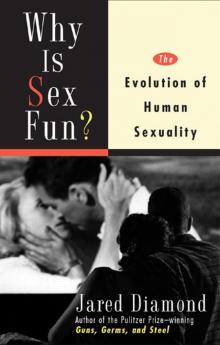 Why Is Sex Fun?: The Evolution of Human Sexuality
Why Is Sex Fun?: The Evolution of Human Sexuality Guns, Germs, and Steel: The Fates of Human Societies
Guns, Germs, and Steel: The Fates of Human Societies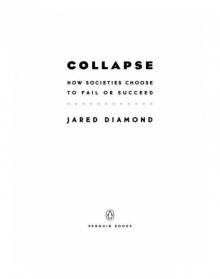 Collapse: How Societies Choose to Fail or Succeed
Collapse: How Societies Choose to Fail or Succeed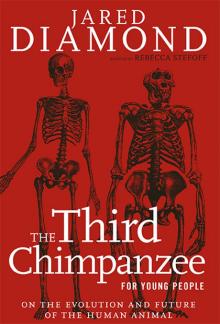 The Third Chimpanzee: The Evolution and Future of the Human Animal
The Third Chimpanzee: The Evolution and Future of the Human Animal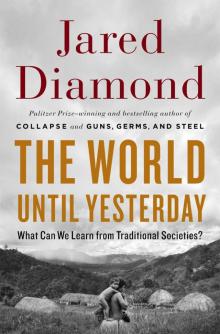 The World Until Yesterday: What Can We Learn From Traditional Societies?
The World Until Yesterday: What Can We Learn From Traditional Societies?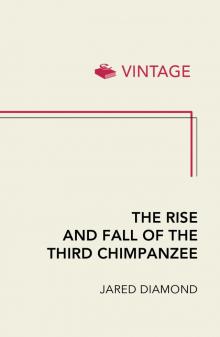 The Rise and Fall of the Third Chimpanzee
The Rise and Fall of the Third Chimpanzee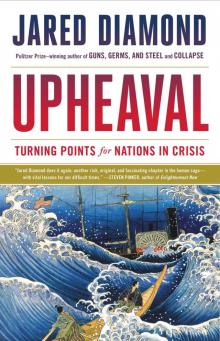 Upheaval: Turning Points for Nations in Crisis
Upheaval: Turning Points for Nations in Crisis Guns, Germs, and Steel
Guns, Germs, and Steel The Third Chimpanzee for Young People
The Third Chimpanzee for Young People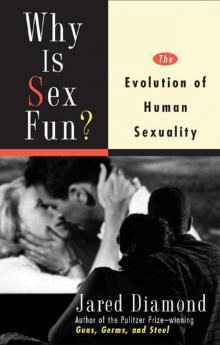 Why Is Sex Fun?
Why Is Sex Fun?